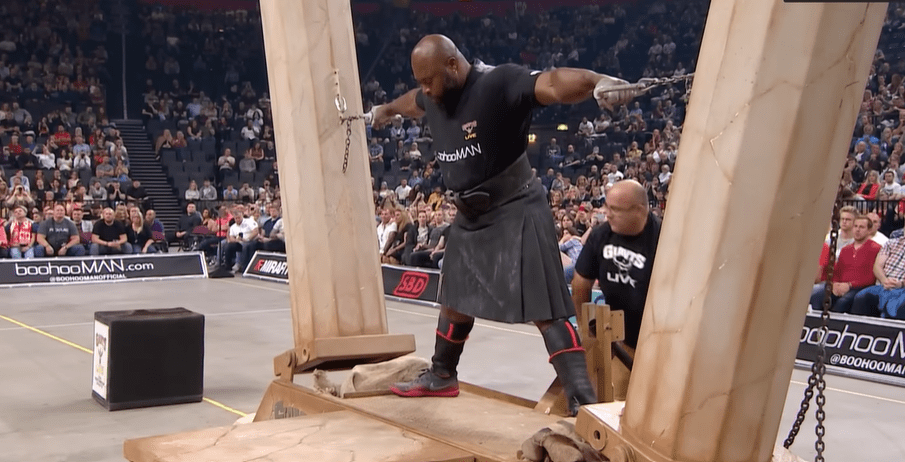Hercules Pillars Event Information
| Attribute | Details |
|---|---|
| Event Name | Hercules Hold |
| Average Pillar Weight | 160 kg (352 lbs) per pillar |
| Record Holder | Vispy Kharadi |
| Record Duration | 2 minutes 10.75 seconds |
| Record Date | 11 November 2024 |
| Record Location | Surat, India |
| Record Weight of Pillars | 166.7 kg and 168.9 kg |
| Pillar Height | 123 inches |
| Pillar Diameter | 20.5 inches |
| Reference | Guinness World Records – Vispy Kharadi Record |

Silence, pressure, and expectation were all held in Vispy Kharadi’s grasp in addition to steel. He stood between two imposing Hercules Pillars, each weighing more than 160 kilograms, on an elevated platform in Surat, India, and would not let go. The pillars faltered, the muscles tensed, and the chains stretched for two minutes and 10.75 seconds, but Kharadi stayed intact. The performance was more than just a Strongman drill; it was an exceptionally powerful display of both physical and mental perseverance.
The Hercules Hold challenges the conventional wisdom that strength is associated with lifting or moving heavy objects. In this case, endurance rather than motion is the test. Clinging to the pillars with chained handles, the athlete stands erect with their arms out at their sides. Gravity turns into the adversary after the pillars are released, drawing downward with a silent but unyielding force. The applause gets louder the longer you resist.
The Hercules Pillars weigh about 160 kg apiece by conventional measures. The athlete actually bears a far greater weight, though. According to some experts, the cumulative strain on an athlete’s shoulders and wrists could be more than 400 kg due to the angle of the chains and the biomechanics of grip fatigue. Even experienced competitors find the extremely difficult task created by this covert resistance to be exhausting.
Kharadi’s incredible performance in recent months has been heard outside of Strongman circuits. Unexpectedly, Elon Musk posted a video of the incident with the caption, “Holding the future, literally.” Static strength sports saw a resurgence in popularity worldwide after that one repost generated thousands of comments. Musk’s brief remark alluded to something more profound—an implicit link between mental toughness and physical immobility.
Athletes like Kharadi use strategic focus to turn resilience—an abstract concept—into something tangible and quantifiable. The record was previously held by British Strongman legend Mark Felix, who stood motionless against 160 kg pillars well into his fifties with his own incredible Hercules Hold. For fitness enthusiasts in their middle years, his example was especially motivating. His tale, which got noticeably better with every competition, serves as a reminder that strength changes with age rather than waning.
The Hercules Pillars’ immense size and symmetry are what give them their striking appearance. The pillars, which are more than ten feet tall and more than twenty inches in diameter, look more like mythological artifacts than athletic gear. It reminds us of the old story of Hercules, who instead of climbing over a mountain that stood in his way, split it in two. Athletes of today don’t split mountains, but they do hold them in place metaphorically, their muscles shaking but their resolve unwavering.
The Hercules Hold is more than just physical strength in the context of contemporary sports culture. It provides a very clear metaphor for being silent under pressure, a trait that is remarkably similar to the composed concentration needed by pilots, surgeons, and even high-stakes negotiators. The paradox of standing motionless while fighting a silent battle against collapse gives the event an emotional resonance that elevates it from a sporting event to a symbolic act.
In the weeks after Kharadi’s performance, gyms all over India saw a discernible increase in questions about Strongman training. “People weren’t asking about bench press anymore—they wanted to learn the Hercules Hold,” a Gujarati gym owner observed. This change is indicative of a larger trend toward functional strength. The desire to train for endurance rather than dominance is in line with a global fitness movement that values chaos control.
The Hercules Hold is now considered a rite of passage for young athletes. Trainers have created beginner versions using kettlebells or resistance bands, and social media has expanded its reach. The challenge has significantly increased public interest in grip training, which is now viewed as a means of achieving greater stability and strength rather than merely as a niche skill.
Athletes and coaches have used public platforms such as Instagram and TikTok to share their experiences and triumphs with holding variations of the pillars. Because of its accessibility, Strongman sports no longer carry the same level of intimidation. Additionally, the discussion of mental focus and controlled breathing has become a regular part of training as more people try the hold—at home, in parks, or in professional settings.
The impact has been particularly noticeable in the world of professional sports. Static holds are currently being incorporated by physical therapists into injury prevention initiatives. Young athletes are being encouraged by their coaches to investigate grip endurance as a means of achieving sustained performance improvements. Although the shift isn’t particularly noticeable, it is very effective at reducing imbalances and strengthening the core.
The Hercules Hold has gained symbolic significance even outside of competitive settings. Its tenets have been incorporated into the programming of leadership courses and mental health retreats, which exhort attendees to “stand strong” both literally and figuratively. These programs illustrate the hold’s underlying allure: holding oneself accountable is just as important as holding pillars.
It feels strangely rebellious to stand motionless with purpose in a time of constant motion and fast change. It serves as a reminder that endurance is a quality of strength. Under duress, that silence can have just as much impact as yelling. And that sometimes staying still is the bravest thing we can do.

